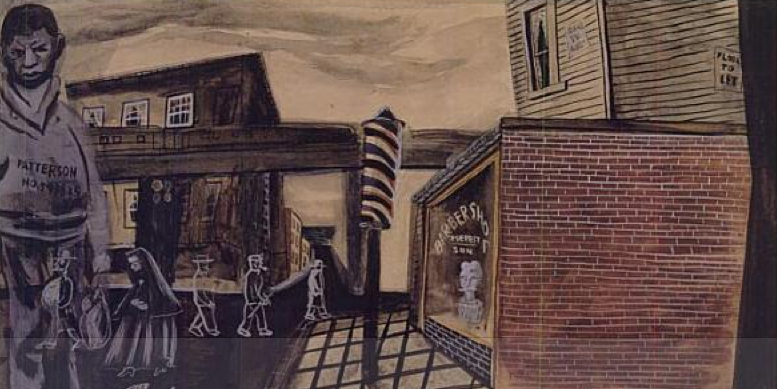Hideo Noda, victim of Communism
Reading Whittaker Chambers’ Witness for the first time, I was intrigued by his mention of an innocent Japanese college student swept up by the Communist underground in America. Hideo Noda (野田英夫, 1908-1939), nephew of the peace-loving socialist politician Prince Fumimaro Konoye and student of Diego Rivera, was a warm-hearted and talented man apparently drawn to Communism by a genuine sympathy with the poor. You can see in his 1933 work Scottsboro Boys (pictured) a portrayal of working-class urban life that should be familiar to any visitor to an American city. After a discussion with Chambers, Noda eagerly agreed “to go to Japan to work as a Soviet underground agent”, although Chambers does not make it clear if Noda realized that this work would involve espionage.
At this point I decided to Google Noda’s name, and found both an unrelated Japanese-American nisei painter with the same name (crazy coincidence!), and an English biography on the website of a museum which carries his work. This biography is curiously whitewashed of his Communist adventures, although according to Chambers, they occupied a great part of his life after 1934.
Here is how the museum describes his later life:
Noda didn’t adhere to authority or strive after a false reputation. He was a humantistic [sic] painter who turned his eyes to the world of the mind and continued painting the working class, immigrants, circus performers, the unemployed and children from the bottom strata of society. In 1938 he was diagnosed with a brain tumor but continued to paint, holding his eyelids open with adhesive tape. Noda died prematurely at the age of 30.
Seeing such an incomplete biography inspired me to write this quick post to correct the Internet on this matter.
The attempt to establish a Soviet network in Japan failed, and his Tokyo contact John Sherman was commanded to go on to Moscow and barely escaped death there. Noda was also stuck in the underground and it appears he was eventually destroyed by it. Here is Chambers, meeting Noda for the last time:
I saw [Noda] only for a moment [in 1938], to give him the address [of his next meeting place]. I did not ask, of course, where he had been since I had sent him on to a hotel in Southern France. Before Noda had been alert, somewhat as birds are, as if in him mental and physical brightness were one. Now he seemed a little faded and tired. Our brief meeting was stiff… I suspect that Noda was so silent because, had he begun to speak, the words that came out would have been: “Oh, horror, horror, horror!” … In 1939, the New York Times published his rather impressive obituary. In Tokyo, the promising Japanese-American painter Hideo Noda had died suddenly, of a “cerebral tumor.”
John Sherman refused to testify on the subject of Noda, pleading the fifth. This means that there is no information on Noda in English that does not either derive from Whittaker Chambers’ account or whitewash his Communist background. There is no Japanese-language equivalent to Google Books that would allow me to research this quickly, but none of the Japanese accounts of Noda online mention his underground work, except for one blog post which hints vaguely at “information collection”, but fails to mention any of his multiple trips overseas during the treatment of his “brain tumor”, if indeed he was diagnosed with a tumor at all. It is striking that the museums that hold his work do not realize what he was doing when he died, but it seems that Witness really is our only standing witness to the Communist underground at least on this detail.
Posted: January 3rd, 2012 | World Peace 3 Comments »

